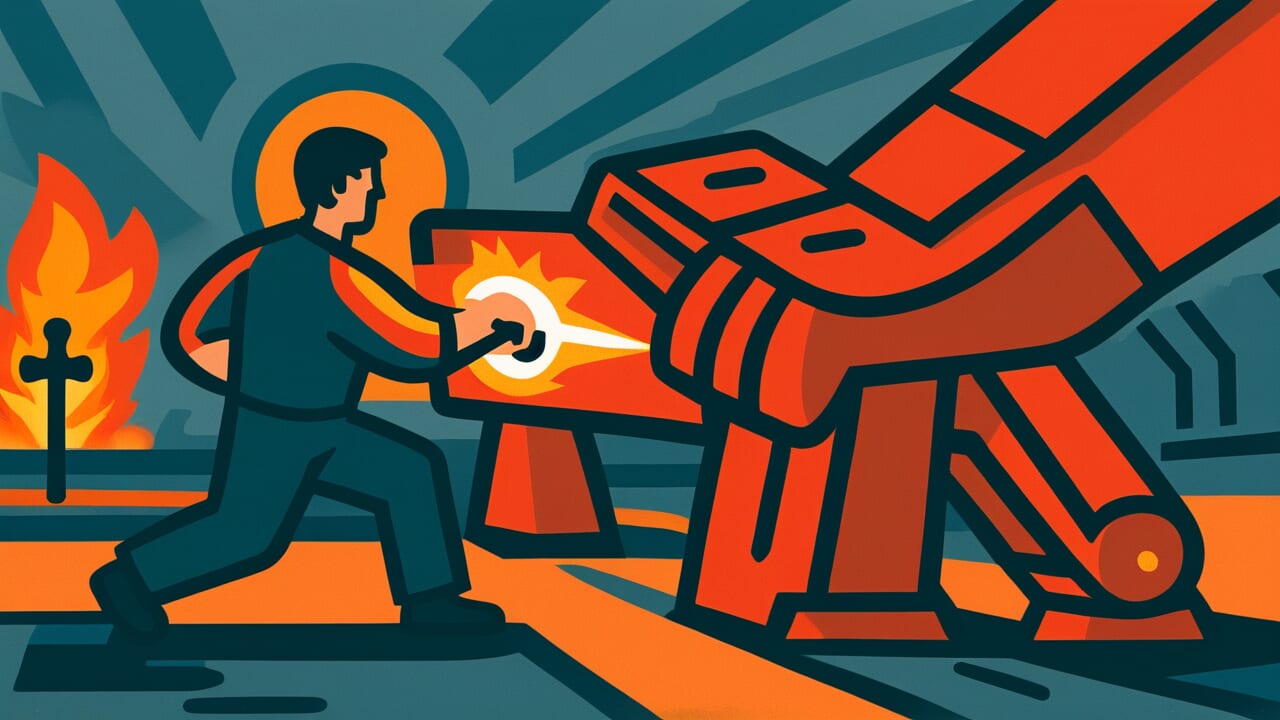How to Read “strike while the iron is hot”
Strike while the iron is hot
[STRAHYK wahyl thee AHY-ern iz hot]
All words use common pronunciation.
Meaning of “strike while the iron is hot”
Simply put, this proverb means you should take action when the timing is perfect for success.
The saying comes from blacksmithing, where heated metal becomes soft and easy to shape. When iron gets hot enough, it glows red and can be hammered into tools or horseshoes. But if the blacksmith waits too long, the iron cools down and becomes hard again. Then it’s much harder to work with and shape properly.
In everyday life, this means grabbing opportunities when they appear. Maybe you want to ask for a raise when your boss just praised your work. Or you might apply for college right after getting good test scores. The idea is that perfect moments don’t last forever, so you need to act fast.
People often realize this wisdom applies to many situations they’ve missed. Sometimes we hesitate when everything lines up perfectly for us. We think we’ll have another chance later, but conditions change quickly. The person who acts right away usually gets better results than someone who waits and hopes.
Origin and Etymology
The exact origin is unknown, but this saying clearly comes from the ancient craft of blacksmithing.
Blacksmiths have worked with heated metal for thousands of years across many cultures. They discovered that timing was everything in their craft. Heat the iron too little, and it won’t bend. Wait too long after heating, and it becomes stubborn again. This practical knowledge became so important that it turned into life advice.
The phrase started appearing in English writing several centuries ago. People began using the blacksmith’s wisdom to talk about business deals, relationships, and other opportunities. The saying spread because everyone could understand the basic idea, even if they’d never worked with metal themselves.
Interesting Facts
The word “strike” in this context means to hit with a hammer, not to stop working. Blacksmiths literally strike hot iron with heavy hammers to shape it. The phrase uses alliteration with “strike” and “iron,” making it easier to remember and repeat.
Usage Examples
- Manager to employee: “The client just approved our proposal and seems eager to expand the project – strike while the iron is hot.”
- Friend to friend: “She’s finally single and you two have been texting all week – strike while the iron is hot.”
Universal Wisdom
This proverb reveals a fundamental tension in human nature between caution and action. We evolved to be careful because rushing into danger could mean death. But we also needed to seize opportunities quickly because resources were often scarce. This created an internal conflict that still affects us today.
The wisdom recognizes that favorable conditions are temporary by nature. Whether it’s weather, social situations, or economic circumstances, the forces that create perfect moments are always shifting. Our ancestors learned that hesitation often meant missing out entirely. The hunter who waited too long lost the prey. The farmer who delayed planting missed the growing season.
What makes this saying universally true is how it addresses our tendency to overthink opportunities. Humans naturally want to gather more information and reduce uncertainty before acting. But perfect information rarely exists, and waiting for it often means losing the chance altogether. The proverb teaches us that sometimes good timing matters more than perfect preparation. It reminds us that the world keeps moving whether we’re ready or not, and the most successful people learn to act decisively when conditions align in their favor.
When AI Hears This
Humans treat good moments like they’re permanent fixtures. We act as if opportunities will wait patiently for us. But favorable conditions actually burn energy to stay favorable. Like hot metal cooling down, good situations naturally drift back to normal. We miss chances because we don’t see this invisible countdown timer. Most people think opportunities get stronger while they wait.
This happens because our brains evolved for a simpler world. Back then, ripe fruit stayed ripe for days. Good weather lasted for weeks at a time. But modern opportunities behave more like chemical reactions with short lifespans. We still use ancient timing instincts for lightning-fast modern situations. Our mental clocks run too slow for today’s reality.
What’s remarkable is how this mismatch actually protects us sometimes. Moving too fast on every opportunity would exhaust us completely. Our slow response acts like a natural filter system. It forces us to save energy for truly important moments. The people who succeed learn to recognize when speed matters most. They override their cautious instincts at exactly the right times.
Lessons for Today
Living with this wisdom means developing better instincts about when to move quickly versus when to wait. The challenge lies in recognizing those golden moments when everything comes together. These opportunities often feel different from normal situations, with less resistance and more natural flow toward success.
In relationships and work, this translates to speaking up when people are receptive rather than waiting for a “better” time that may never come. It means having honest conversations when emotions are calm, making requests when goodwill is high, and sharing ideas when others are open to change. The key is staying alert to these favorable conditions instead of being lost in routine.
The difficulty comes from our natural tendency to second-guess ourselves or assume we’ll get another chance. But this wisdom teaches us that identical opportunities rarely repeat themselves. Conditions shift, people’s moods change, and circumstances evolve. Those who master this principle learn to balance preparation with decisive action. They stay ready so they can move quickly when the moment arrives, understanding that perfect timing combined with good enough preparation often beats perfect preparation with poor timing.



Comments